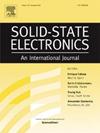Enhancing carrier transport in AlGaN/GaN HEMTs through structural optimization and transconductance modeling
IF 1.4
4区 物理与天体物理
Q3 ENGINEERING, ELECTRICAL & ELECTRONIC
引用次数: 0
Abstract
In GaN-based High-Electron Mobility Transistors (HEMTs), the carrier transport properties of the 2-Dimensional Electron Gas (2DEG), specifically the saturation velocity (υsat) and effective mobility (μn_eff,), are critical determinants of device performance. To enhance these properties, we conducted structural optimizations, which included reducing the Al mole fraction in the AlxGa1-xN barrier and introducing an AlGaN back barrier. Recognizing the limitations of traditional extraction techniques, we employed transconductance modeling to accurately extract effective mobility and saturation velocity values. The implementation of the AlGaN back barrier resulted in an effective mobility enhancement to 748 cm2/V·s. Additionally, reducing the Al mole fraction in the AlxGa1-xN top barrier led to an effective mobility improvement of 484 cm2/V·s. These findings provide valuable insights into the design of epitaxial structures for AlGaN/GaN HEMTs aimed at achieving superior performance in future applications.
通过结构优化和跨电导建模增强AlGaN/GaN hemt中的载流子输运
在基于氮化镓的高电子迁移率晶体管(hemt)中,二维电子气体(2DEG)的载流子输运特性,特别是饱和速度(sat)和有效迁移率(μn_eff,)是器件性能的关键决定因素。为了提高这些性能,我们进行了结构优化,包括减少AlxGa1-xN势垒中的Al摩尔分数和引入AlGaN后势垒。认识到传统提取技术的局限性,我们采用跨电导建模来准确提取有效迁移率和饱和速度值。AlGaN后屏障的实施使迁移率有效提高到748 cm2/V·s。此外,降低AlxGa1-xN顶势垒中的Al摩尔分数可使迁移率提高484 cm2/V·s。这些发现为AlGaN/GaN hemt的外延结构设计提供了有价值的见解,旨在在未来的应用中实现卓越的性能。
本文章由计算机程序翻译,如有差异,请以英文原文为准。
求助全文
约1分钟内获得全文
求助全文
来源期刊

Solid-state Electronics
物理-工程:电子与电气
CiteScore
3.00
自引率
5.90%
发文量
212
审稿时长
3 months
期刊介绍:
It is the aim of this journal to bring together in one publication outstanding papers reporting new and original work in the following areas: (1) applications of solid-state physics and technology to electronics and optoelectronics, including theory and device design; (2) optical, electrical, morphological characterization techniques and parameter extraction of devices; (3) fabrication of semiconductor devices, and also device-related materials growth, measurement and evaluation; (4) the physics and modeling of submicron and nanoscale microelectronic and optoelectronic devices, including processing, measurement, and performance evaluation; (5) applications of numerical methods to the modeling and simulation of solid-state devices and processes; and (6) nanoscale electronic and optoelectronic devices, photovoltaics, sensors, and MEMS based on semiconductor and alternative electronic materials; (7) synthesis and electrooptical properties of materials for novel devices.
 求助内容:
求助内容: 应助结果提醒方式:
应助结果提醒方式:


